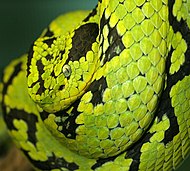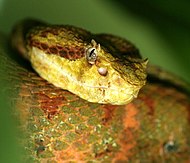Superregnum: Eukaryota
Cladus: Unikonta
Cladus: Opisthokonta
Cladus: Holozoa
Regnum: Animalia
Subregnum: Eumetazoa
Cladus: Bilateria
Cladus: Nephrozoa
Superphylum: Deuterostomia
Phylum: Chordata
Subphylum: Vertebrata
Infraphylum: Gnathostomata
Megaclassis: Osteichthyes
Cladus: Sarcopterygii
Cladus: Rhipidistia
Cladus: Tetrapodomorpha
Cladus: Eotetrapodiformes
Cladus: Elpistostegalia
Superclassis: Tetrapoda
Cladus: Reptiliomorpha
Cladus: Amniota
Classis: Reptilia
Cladus: Eureptilia
Cladus: Romeriida
Subclassis: Diapsida
Cladus: Sauria
Infraclassis: Lepidosauromorpha
Superordo: Lepidosauria
Ordo: Squamata
Subordo: Serpentes
Infraordo: Caenophidia
Superfamilia: Viperoidea
Familia: Viperidae
Subfamilia: Crotalinae
Genus: Bothriechis
Species (11): B. aurifer – B. bicolor – B. guifarroi – B. lateralis – B. marchi – B. nigroviridis – B. nubestris – B. rowleyi – B. schlegelii – B. supraciliaris – B. thalassinus
Name
Bothriechis Peters, 1859: 278
Type species: Bothriechis nigroviridis Peters, 1859, by monotypy.
Synonyms
Teleuraspis Cope, 1860: 334
Type species: Trigonocephalus schlegelii Berthold, 1846, by subsequent designation by Dunn & Dunn (1940: 75).
References
Primary references
Cope, E.D. [1859] 1860. Catalogue of the venomous serpents in the Museum of the Academy of Natural Sciences of Philadelphia, with notes on the families, genera and species. Proceedings of the Academy of Natural Sciences of Philadelphia 11: 332–347. BHL Reference page.
Additional references
Doan, T.M., Mason, A.J., Castoe, T.A., Sasa, M. & Parkinson, C.L. 2016. A cryptic palm-pitviper species (Squamata: Viperidae: Bothriechis) from the Costa Rican highlands, with notes on the variation within B. nigroviridis. Zootaxa 4138(2): 271–290. DOI: 10.11646/zootaxa.4138.2.3. Reference page.
Townsend, J.H. et al. 2013: A relict lineage and new species of green palm-pitviper (Squamata, Viperidae, Bothriechis) from the Chortís Highlands of Mesoamerica. ZooKeys 298: 77-106. DOI: 10.3897/zookeys.298.4834 Reference page.
Links
Uetz, P. & Hallermann, J. 2022. Bothriechis . The Reptile Database. Accessed on 22 June 2018.
Vernacular names
Deutsch: Palmlanzenottern
English: Palm Vipers
Bothriechis is a genus of venomous pit vipers, commonly called palm vipers[2] or palm-pitvipers[3] found predominantly in Mexico and Central America, although the most common species, B. schlegelii, ranges as far south as Colombia and Peru.[4] All members are relatively slender and arboreal. The name Bothriechis is derived from the Greek words bothros and echis that mean "pit" and "viper" respectively.[3] Ten species and no subspecies are currently generally recognized.[5][6]
Description
Species that belong to this genus typically reach lengths of 60–80 cm, while B. aurifer, B. bicolor and B. lateralis are known to grow to 1 m or more.[3]
General characteristics include a sharply defined canthus rostralis, an unelevated snout, a rostral scale that is not as high as it is broad, and a prehensile tail that accounts for at least 15% of the body length.[3]
The color pattern usually consists of a green ground color that may or may not include pale or dark markings. B. schlegelii is an exception to this rule.[3]
Geographic range
Occurs in southern Mexico (southeastern Oaxaca and the northern highlands of Chiapas), through Central America to northern South America (Colombia, western Venezuela, Ecuador and northern Peru).[1]
Behavior
As a general rule, species found above 1,500 meters altitude tend to be diurnal, while those found below 1,000 meters tend to be active at night. Those found between 1,000 and 1,500 meters may be active at any time of the day.[3]
Venom
Bothriechis venom is primarily a haemotoxin which causes severe pain, swelling, bleb formation, bruising, and quite often necrosis. If untreated it can lead to loss of a limb, or even death. Each year several farmers and plantation workers are bitten by eyelash vipers, sometimes resulting in fatalities. Wyeth in the United States and Instituto Clodomiro Picado in Costa Rica both manufacture different polyvalent antivenins which can be used to treat eyelash viper envenomations.
Species
There are 11 recognized species.[7]
| Image | Species[5] | Taxon author[5] | Common name[3] | Geographic range[1] |
|---|---|---|---|---|
 |
B. aurifer | (Salvin, 1860) | Yellow-blotched palm-pitviper | Mexico, in the mountains of eastern Chiapas, in northern Guatemala. Occurs in cloud forest at 1200–2300 m altitude. |
 |
B. bicolor | (Boucourt, 1868) | Guatemalan palm-pitviper | The Pacific slope of southeastern Chiapas in Mexico, eastward to south-central Guatemala. Also known from several locations in Honduras, including the southern part of the Sierra del Merendón and Cerro Santa Bárbara. Occurs in cloud forests at 500–2000 m altitude. |
 |
B. guifarroi | Townsend, Medina-Flores, Wilson, Jadin & Austin, 2013[8] |
Guifarro's palm-pitviper | Honduras at 1015–1450 m altitude. "Found in the western portion of Cordillera Nombre de Dios, Department of Atlantida, Honduras."[6] |
 |
B. lateralis | W. Peters, 1862 | Side-striped palm-pitviper | The mountains of Costa Rica and western Panama, including the Cordillera de Tilarán, the Cordillera Central and the Cordillera de Talamanca to the provinces of Chiriquí Province and Veraguas. Occurs at 850–980 m altitude. |
| B. marchi | (Barbour & Loveridge, 1929) | Honduran palm-pitviper | The Atlantic versant of northwestern Honduras and eastern Guatemala. Occurs in mesic forest at elevations of 500–1500 m altitude. | |
 |
B. nigroviridisT | W. Peters, 1859 | Black-speckled palm-pitviper | The mountains of Costa Rica and Panama. Also found in the cloud forests of the Cordillera Central and the Cordillera de Talamanca at 1150–2400 m altitude. |
| B. nubestris | Doan, Mason, Castoe, Sasa, & Parkinson, 2016 | Talamancan palm-pitviper | Costa Rica. San Isidro de El General, Province of San José at approximately 3000 m altitude. | |
 |
B. rowleyi | (Bogert, 1968) | Mexican palm-pitviper | Mexico in southeastern Oaxaca and northern Chiapas. Occurs in cloud forests at 1500–1830 m altitude. |
 |
B. schlegelii | (Berthold, 1846) | Eyelash palm-pitviper | From southern Mexico (northern Chiapas), southeastward on the Atlantic slope and lowlands through Central America to northern South America in Colombia and Venezuela. Also found on the Pacific versant and lowlands in parts of Costa Rica, Panama, Colombia, Ecuador and Peru. Occurs in mesic forest at elevations almost from sea level to 2640 m altitude. |
 |
B. supraciliaris | (Taylor, 1954) | Blotched palm-pitviper | Only found in a mountainous area in southwestern Costa Rica. Occurs in lower montane wet forest and cloud forest at elevations from 800 m to 1,700 m.[9] |
 |
B. thalassinus | Campbell & E.N. Smith, 2000 | Merendon palm-pitviper | Guatemala, Honduras at 1370–1750 m altitude. |
T type species[1]
Taxonomy
A new species from Guatemala and Honduras, B. thalassinus, was described by Campbell & E.N. Smith (2000). Campbell & Lamar (2004) recognize this species, as well as a ninth addition to the genus: B. supraciliaris, which was first described by Taylor (1954) as a subspecies of B. schlegelii, and is found in southwestern Costa Rica.[3]
B. guifarroi was discovered in 2010 and described by Townsend et al. in 2013, in a study that included the following suggested phylogenetic tree of the genus:[6]
| Bothriechis |
|
References
McDiarmid RW, Campbell JA, Touré TA. 1999. Snake Species of the World: A Taxonomic and Geographic Reference, Volume 1. Washington, District of Columbia: Herpetologists' League. 511 pp. ISBN 1-893777-00-6 (series). ISBN 1-893777-01-4 (volume).
Mehrtens JM. 1987. Living Snakes of the World in Color. New York: Sterling Publishers. 480 pp. ISBN 0-8069-6460-X.
Campbell JA, Lamar WW. 2004. The Venomous Reptiles of the Western Hemisphere. Ithaca and London: Comstock Publishing Associates. 870 pp. 1500 plates. ISBN 0-8014-4141-2.
Lewis, Robert Alan (23 March 1998). Lewis' Dictionary of Toxicology. CRC Press. p. 187. ISBN 978-1-56670-223-2.
"Taxonomic Information for Palm Pit Vipers (Bothriechis)". Encyclopedia of Life. Retrieved 9 January 2014.
Townsend, Josiah; Medina-Flores, Melissa; Wilson, Larry; Jadin, Robert; Austin, James (2013). "A relict lineage and new species of green palm-pitviper (Squamata, Viperidae, Bothriechis) from the Chortís Highlands of Mesoamerica". ZooKeys (298): 77–105. doi:10.3897/zookeys.298.4834. PMC 3689108. PMID 23794885.
Bothriechis at the Reptarium.cz Reptile Database. Accessed 26 January 2022.
"Taxonomic Information for Bothriechis guifarroi ". Encyclopedia of Life. Retrieved 9 January 2014.
Solórzano, Alejandro; Gómez, Luis D.; Monge-Nájera, Julián; Crother, Brian I. (1998). "Redescription and validation of Bothriechis supraciliaris". Revista de Biología Tropical. 46 (2): 1001–1013.
Further reading
Campbell JA, Smith EN. 2000. "A new species of arboreal pitviper from the Atlantic versant of northern Central America". Revista de Biología Tropical 48: 1001-1013.
Cope ED. 1860 (dated 1859). "Catalogue of the venomous serpents in the museum of the Academy of Natural Sciences of Philadelphia, with notes on the families, genera and species". Proc. Acad. Nat. Sci. Philadelphia 11: 332-347 [338].
Peters W. 1859. "Über die von Hrn. Dr. Hoffmann in Costa Rica gesammelten und an das Königl. Zoologische Museum gesandten Schlangen". Monatsberichte der Preussischen Akademie Wissenschaften zu Berlin 1859: 275-278 [278].
Posada Arango A. 1889. Anales de la Academia de Medicina de Medellin 2: 45-49 [47].
Posada Arango A. 1889. Bulletin de la Société Zoologique de France, Paris 14: 343-345 [343].
Salvin O. 1860. "On the reptiles of Guatemala". Proceedings of the Zoological Society of London 1860: 451-461 [459].
Taylor EH. 1954. "Further studies on the serpents of Costa Rica". University of Kansas Science Bulletin 36 (11): 673-801.
Retrieved from "http://en.wikipedia.org/"
All text is available under the terms of the GNU Free Documentation License

